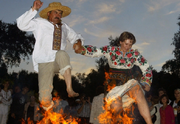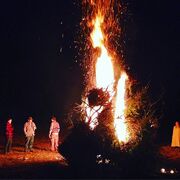
Sacred grove located in Hobrazia
Hobaism, sometimes known as Hobrazian paganism, is a religion and belief system native to Hobrazia that constitutes a significant minority of the population and is influential in Hobrazian history, culture, and society.
Hobaism's origins are a matter of controversy among religious scholars, and the religion's exact history is unknown. Hobaism is a diverse religious tradition for a number of reasons. Since the 4800's, most scholars have believed Hobaism to be a mixture of native Hobrazian animism with Gerajism. However, Hobaism's decentralized nature and lack of organized worship affords considerable latitude to individual practitioners. Hobaism is a diverse religion that may be described more accurately as a constellation of related religious traditions rather than a monolithic faith.
The principal belief of almost all Hobaists is that the world is permeated by ancient Spirits of the Land. By communing with and worshiping these Spirits, adherents of the faith believe they can be brought closer to the eternal Lord Hoba, a creator god who is usually held to be the supreme - though not the only - deity in Hobaism.
History[]
Much of Hobaism's history is unknown. Most scholars believe that modern Hobaism is descended from pre-historic Hobrazian animism, although the religion has since been heavily influenced by the Gerajan faith of Malivia, which borders Hobrazia. The extent of Gerajan influence is hotly debated: an increasing number of scholars even consider Hobaism to be nothing more than an offshoot of Geraja, while others (typically associated with Hobrazian nationalism) stress the unique qualities of Hobaism.
Teachings[]
Spirits of the Land[]
Hobaists worship a number of Spirits of the Land (usually called gods by non-Hobaists), although individual Hobaists disagree on the exact nature and number of these deities. Generally speaking, Hobaism is divided into three roughly equal camps:
- True polytheists, who believe all Spirits are "true" gods, although not equal in power.
- Avatarists, who believe that all Spirits are simply manifestations of Lord Hoba, who chooses to present himself in varying ways.
- Creationists, who believe that Spirits are merely powerful entities, and not truly gods. For Creationists, the universe itself is supreme, although they typically believe that Lord Hoba is the most powerful of all Spirits. Not all Creationists engage in worship, but those who do see their devotion as more akin to paying tribute than worship.
The Hobaist pantheon is diverse and ever-changing, with new gods emerging through specialized cults and old gods falling out of favor and disappearing. Hobaists believe there are innumerable Spirits inhabiting and caring for virtually every aspect of the physical world. The most popular Hobaist gods include Lord Hoba, the creator; Zraxa, the lunar goddess of beauty; and Mashvil, the sun god. Several Gerajan deities - particularly Maha and Duka - also enjoy substantial cults within Hobaism.
Hobaists are welcome to worship any number of gods they choose, but most dedicate most of their worship to a particular deity. Lord Hoba is understandably the most popular such deity, and roughly two-thirds of the Hobaist population consider themselves primarily Lord Hoba adherents. Most Hobaists also worship a familial Spirit which they believe has a special connection to their family, which may be a local deity or even one known only to the associated family.
Reaching enlightenment[]
Fundamental to the understanding of Hobaism is the belief that all people should seek to reach a state of "enlightenment" through achieving harmony with the gods and the universe. As part of seeking enlightenment Hobaists believe that they must share the truth of the faith with all peoples, viewing all other religious traditions - with the possible exception of Geraja - as misguided. The explicitly evangelical nature of the faith has been cited as an important part of why it has been able to maintain such a large part of Hobrazian society throughout the country's history.
Hobaism affirms the reality of reincarnation, and most Hobaists hold that true enlightenment can only be met over many lifetimes. While Hobaists believe that all life undergoes reincarnation, cross-species reincarnation is strictly denied: for example, a human may only be reincarnated into a human. The sole exception of this rule is the cow, as Hobaists believe that cows may be reincarnated as humans, and humans may be reincarnated as cows. For this reason, Hobaists avoid eating beef.
After reaching enlightenment, Hobaists are believed to be deified, and transcend their human nature to become gods themselves. Reincarnation ceases upon enlightenment.
Nature and Land[]
Due to the centrality of the Spirits of the Land, the natural environment is a crucial theme in the theology of Hobaism. According to Hobaist doctrine, a number of natural places (such as groves, lakes, and bogs) have spiritual significance as they enable closeness between man and the Spirits of the Land. Hobaists believe that repeated and dedicated worship in a location may blur the lines between material and spiritual reality, allowing a place to become holier over time.
Furthermore there are a variety of festivals and holidays that are centered on the natural land, such as the annual New Year festival celebrated over a number of days throughout the country. Festivals of this kind are the primary form of collective worship that exists in Hobaism, which is usually organized at the individual or small community level.
Role of the family[]
Hobaist traditions holds that familial care is of the utmost importance. Hobaists are obligated to care for members of their extended family, including not just parents and children but also grandparents, grandchildren, aunts, uncles, cousins, nieces, and nephews.
Collective worship[]

Celebration at a Hobaist festival
Unlike other major religions like Hosianism or Ahmadism, there is no significant history of organized worship within Hobaism. The primary form of collective worship is the various celebrations and festivals within the Hobaist religious calendar. Likewise there is no "prayer" in the Hobaist tradition with an emphasis on action and behavior rather than communication.
Spiritual leaders do exist, as persons who have acquired extensive knowledge of the Spirits of the Land, and these may play a role in meeting with young people or those new to the faith but they do not preach in the manner that a priest, bishop or imam might. In the organizational structure of Hobaism, an emphasis is placed on the ability of the Spirits of the Land to reveal truth to all persons and therefore hierarchical structure are rejected in a favor of system similar to the concept of a universal priesthood.
Holidays[]
As mentioned above, there are four major celebratory periods, each lasting up to 10 days.
The Festival of Fertility (March 25th – April 5th)[]
This is where Hobaists celebrate the coming of the new season and ask Lord Hoba for a fertile crop and animals for food. It is often finalized with the pouring of drink upon the ground so as to allow the Spirits to join with the celebrations and to thank them for past and future blessings.
Midsummer (20th June-30th June)[]
A celebration of the time when the Sun is at its highest and the days at their longest. During this time the people have the longest ability to hunt for food and made it easier to care for their animals and crops. To this end they thank Lord Hoba for the provisions they gave. If the food was scarce, they would use this time to ask the Spirits what it is they could do better to please them, and again furnish the Spirits with drink (and occasionally food) in order for them to join the festivities.
Feast for the Dead (30th October-9th November)[]
The feast for the dead allows the Hobaists the only time of year where they can communicate directly with their ancestors and so, hopefully, allow them to share with the living what they had learned before death in order for them to have reached enlightenment, or should they not have arrived at that point yet, to encourage them to return to Terra to learn from the living what they need to finally reach that final point.
Many outside observers have often reported strange occurrences during this period. Though many modern beliefs look toward this time as one to fear, the Hobaists believe that it is a time for great rejoicing.
New Year (28th December-6th January)[]
During New Year celebrations, different Hobaist communities come together to celebrate and feast together. The center of the New Year celebration is the burning of a sacred tree, which is cut down and transported to a central location in the local town or village. In advance of the celebration, various rituals are performed to prepare the tree before it is burned and Hobaists come together to celebrate the cycle of life, death and rebirth.

Hobrazian Hobaists burning a sacred tree on New Year
In modern times it is unusual for ordinary Hobaists to take part in the ritual of cutting down a tree due to changing modern lifestyle patterns, however the sacred nature of the wood is bestowed through specific rituals and it is common for many Hobrazians to perform these on ordinary firewood and celebrate the occasion with a bonfire.
